- Prelude
- Guest Editor’s Column
- Creative Impulse
- Horloges : Counting The Hours
- Aesthetic Movement: Aesthetic furniture
- Book Review
- Engraving Deeper Thoughts:
- In the News
- Artist Index and Statistics
- Market Insight
- Auction Reports
- Photo Feature
- The month that was
- Mumbai Artsighting
- Art Bengaluru
- Musings from Chennai
- North-East Opsis
- In between – from Vadodara
- Deccan Odyssey
- Inscriptions in Bronze
- Writing Visuals
- A Missing History: The Other Story Re-visited
- Invisible Cities
- His Story
- Erasing Borders Exhibition of Contemporary Indian Art of the Diaspora
- Urban Testimonies
- The Medium Speaks Back
- Indian Art & Fashion goes to Sweden
- Mahanagar@Kolkata
- Different hues of Aakriti
- Christie’s : Important Watches Hong Kong
ART news & views
Aesthetic Movement: Aesthetic furniture
Volume: 2 Issue No: 6 Month: 7 Year: 2010
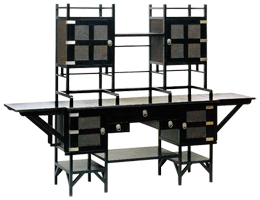 The Aesthetic Movement is generally defined as a movement in literature, fine art, furniture, metalwork, ceramics, stained glass, textiles, and wallpapers, which originated in Britain. The Aesthetic Movement is a British and American phenomenon of the 1870s and 1880s; the Aesthetic Movement was a cult of beauty which sought to elevate the status of all objects to works of art. Aesthetics, as a term denoting a theory of taste', began its life in the 18th century. For example, in 1859, in his Lectures on Metaphysics and Logic, the British philosopher, William Hamilton observes that as he understands it, "aesthetic" stands for "the Philosophy of Taste, the theory of the Fine Arts, the Science of the Beautiful, etc."
The Aesthetic Movement is generally defined as a movement in literature, fine art, furniture, metalwork, ceramics, stained glass, textiles, and wallpapers, which originated in Britain. The Aesthetic Movement is a British and American phenomenon of the 1870s and 1880s; the Aesthetic Movement was a cult of beauty which sought to elevate the status of all objects to works of art. Aesthetics, as a term denoting a theory of taste', began its life in the 18th century. For example, in 1859, in his Lectures on Metaphysics and Logic, the British philosopher, William Hamilton observes that as he understands it, "aesthetic" stands for "the Philosophy of Taste, the theory of the Fine Arts, the Science of the Beautiful, etc."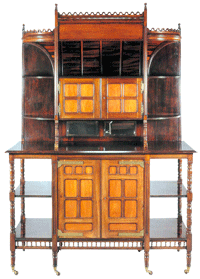 The term is also accepted with this meaning in France, Germany and numerous other European countries. But another term, Apolaustic, already has a meaning for what aesthetic implies. Aesthetic and its cognates, regardless, became more and more common, even though its users betrayed an uncertainty about whether it referenced "taste" or simply "the beautiful". By 1880, the noun aesthete was being widely used, most often -- like the term muckraker journalist -- in a derogatory sense. Today, much like muckraker, the term Aesthetic Movement refers nostalgically to an era when exciting, fresh set of design motifs were introduced.
The term is also accepted with this meaning in France, Germany and numerous other European countries. But another term, Apolaustic, already has a meaning for what aesthetic implies. Aesthetic and its cognates, regardless, became more and more common, even though its users betrayed an uncertainty about whether it referenced "taste" or simply "the beautiful". By 1880, the noun aesthete was being widely used, most often -- like the term muckraker journalist -- in a derogatory sense. Today, much like muckraker, the term Aesthetic Movement refers nostalgically to an era when exciting, fresh set of design motifs were introduced.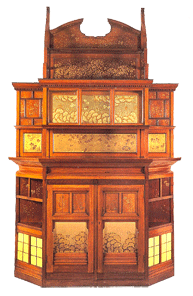 The Aesthetic Movement emerged in Britain out of the design reform movement during the 1860s and 1870s, in which the chief impulse was "Art for Art's Sake". The guiding principle of the Aesthetic Movement, the concept, Art for Art's Sake, argues for an autonomous value of art, a definition where preoccupations with morality, utility, realism and didacticism are not relevant to an art's quality or value. The Aesthetic Movement argued that art was not supposed to be utilitarian or useful in any practical sense. Instead, aesthetic experience is a fully autonomous and independent aspect of a human life. Thus, art should exist solely for its own sake.
The Aesthetic Movement emerged in Britain out of the design reform movement during the 1860s and 1870s, in which the chief impulse was "Art for Art's Sake". The guiding principle of the Aesthetic Movement, the concept, Art for Art's Sake, argues for an autonomous value of art, a definition where preoccupations with morality, utility, realism and didacticism are not relevant to an art's quality or value. The Aesthetic Movement argued that art was not supposed to be utilitarian or useful in any practical sense. Instead, aesthetic experience is a fully autonomous and independent aspect of a human life. Thus, art should exist solely for its own sake. 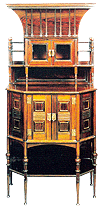 The decorative arts were thought to be admirably suited to women, not only because they were associated with the adornment of the home but also because by their very nature -- painstaking, delicate, refined -- such arts were considered suitably "feminine". Since the Aesthetic movement preached that beautiful surroundings promoted spiritual and mental health, it became fashionable for women to involve themselves directly in decorating their homes. To display that you possessed exquisite taste became as important as dressing well and looking beautiful.
The decorative arts were thought to be admirably suited to women, not only because they were associated with the adornment of the home but also because by their very nature -- painstaking, delicate, refined -- such arts were considered suitably "feminine". Since the Aesthetic movement preached that beautiful surroundings promoted spiritual and mental health, it became fashionable for women to involve themselves directly in decorating their homes. To display that you possessed exquisite taste became as important as dressing well and looking beautiful. For woodworking, the underlying principles of the movement emphasized "art in the production of furniture", which was a negative reaction to the highly elaborate products of mainstream Victorian taste. Instead, aestheticism stressed simple forms and uncluttered surfaces, such as inlay, marquetry and cloisonné. In the Aesthetic Movement's credo, often, ornament was placed asymmetrically.
For woodworking, the underlying principles of the movement emphasized "art in the production of furniture", which was a negative reaction to the highly elaborate products of mainstream Victorian taste. Instead, aestheticism stressed simple forms and uncluttered surfaces, such as inlay, marquetry and cloisonné. In the Aesthetic Movement's credo, often, ornament was placed asymmetrically. After nearly 250 years of isolation, In 1853 Imperial Japan opened the flood gates and almost immediately let loose a flow of Japanese goods to the West which astounded Europe and America with unheard-of treatments of line, shape, and color that would inspire revolutions in fine art, architecture, and particularly interior decoration for decades to come. Part of the allure of Japonisme was the culture's different perspective on design. Patterns and compositions were often asymmetrical, the polar opposite of the mirror image symmetry familiar to Europeans and Americans still wrapped up in the Greek and Gothic revivals of the early 19th century.
After nearly 250 years of isolation, In 1853 Imperial Japan opened the flood gates and almost immediately let loose a flow of Japanese goods to the West which astounded Europe and America with unheard-of treatments of line, shape, and color that would inspire revolutions in fine art, architecture, and particularly interior decoration for decades to come. Part of the allure of Japonisme was the culture's different perspective on design. Patterns and compositions were often asymmetrical, the polar opposite of the mirror image symmetry familiar to Europeans and Americans still wrapped up in the Greek and Gothic revivals of the early 19th century.  Britain had already been introduced to Japanese art in 1862 and this had a huge influence on aestheticism. It had its forerunners in John Keats and Percy Bysshe Shelley, and among the Pre-Raphaelites. In Britain the best representatives were Oscar Wilde and Algernon Charles Swinburne, both influenced by the French Symbolists, and Dante Gabriel Rossetti. The artists and writers of the Aesthetic movement tended to hold that the Arts should provide refined sensuous pleasure, rather than convey moral or sentimental messages. As a consequence, they did not accept John Ruskin and Matthew Arnold's utilitarian conception of art as something moral or useful. Instead, they believed that Art did not have any didactic purpose; it need only be beautiful. The Aesthetes developed the cult of beauty, which they considered the basic factor in art. Life should copy Art, they asserted. They considered nature as crude and lacking in design when compared to art.
Britain had already been introduced to Japanese art in 1862 and this had a huge influence on aestheticism. It had its forerunners in John Keats and Percy Bysshe Shelley, and among the Pre-Raphaelites. In Britain the best representatives were Oscar Wilde and Algernon Charles Swinburne, both influenced by the French Symbolists, and Dante Gabriel Rossetti. The artists and writers of the Aesthetic movement tended to hold that the Arts should provide refined sensuous pleasure, rather than convey moral or sentimental messages. As a consequence, they did not accept John Ruskin and Matthew Arnold's utilitarian conception of art as something moral or useful. Instead, they believed that Art did not have any didactic purpose; it need only be beautiful. The Aesthetes developed the cult of beauty, which they considered the basic factor in art. Life should copy Art, they asserted. They considered nature as crude and lacking in design when compared to art.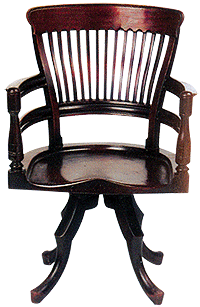 Americans were exposed to art objects from a variety of nations and times, thus style was much influenced by Japanese decoration, late 17th- and early 18th-century English domestic design, Chinese motifs in furniture and blue and white Chinese porcelain. Where they could, designers included examples from Greek, Persian, Moorish, Egyptian and other exotic styles. Typical motifs included sunflowers, fan shapes, peacock feathers, and bamboo. Aesthetic Movement furniture is characterized by several common themes: Ebonized wood with gilt highlights, Japanese influence and prominent use of nature especially flowers, birds, ginko leaves, peacock feathers and Blue and white on porcelain and china. Ebonized furniture means that the wood is painted or stained to a black ebony finish. The furniture is sometimes completely ebony-colored. More often however, there is gilding added to the carved surfaces of the feathers or stylized flowers that adorn the furniture. Trade had just opened with Japan in the 1850s and 1860s. Japanese influences, epitomized by the 1885 Japanese exhibition in Knightsbridge influenced aesthetic furniture and furnishings. There are commonalities especially in the overall rectangular shape with columns, and the intricate woodcarvings, this influence can be seen in a concurrent movement known as the Anglo-Japanese Style, especially in the work of E.W. Godwin and Christopher Dresser. E.W. Godwin, the most innovative designer of the Aesthetic Movement in Britain, adapted Japanese decorative and architectural elements into his Anglo-Japanese furniture, which was often ebonized to resemble Oriental Lacquer furniture. As Aesthetic Movement decor was similar to the writing in that it was about sensuality and nature, nature themes often appear on the furniture. A typical aesthetic feature is the gilded carved flower, or the stylized peacock feather. Colored paintings of birds or flowers are often seen. Non-ebonized Aesthetic Movement furniture may have realistic 3D renditions of birds or flowers carved into the wood. Contrasting with the ebonized-gilt furniture is use of blue and white is used in porcelain and china. Similar themes of peacock feathers and nature would be used in blue and white tones on dinnerware and other crockery. The blue and white design was also popular on square porcelain tiles. It is reported that Oscar Wilde used aesthetic decorations during his youth. This aspect of the movement was also satirised in Punch magazine and in Patience.
Americans were exposed to art objects from a variety of nations and times, thus style was much influenced by Japanese decoration, late 17th- and early 18th-century English domestic design, Chinese motifs in furniture and blue and white Chinese porcelain. Where they could, designers included examples from Greek, Persian, Moorish, Egyptian and other exotic styles. Typical motifs included sunflowers, fan shapes, peacock feathers, and bamboo. Aesthetic Movement furniture is characterized by several common themes: Ebonized wood with gilt highlights, Japanese influence and prominent use of nature especially flowers, birds, ginko leaves, peacock feathers and Blue and white on porcelain and china. Ebonized furniture means that the wood is painted or stained to a black ebony finish. The furniture is sometimes completely ebony-colored. More often however, there is gilding added to the carved surfaces of the feathers or stylized flowers that adorn the furniture. Trade had just opened with Japan in the 1850s and 1860s. Japanese influences, epitomized by the 1885 Japanese exhibition in Knightsbridge influenced aesthetic furniture and furnishings. There are commonalities especially in the overall rectangular shape with columns, and the intricate woodcarvings, this influence can be seen in a concurrent movement known as the Anglo-Japanese Style, especially in the work of E.W. Godwin and Christopher Dresser. E.W. Godwin, the most innovative designer of the Aesthetic Movement in Britain, adapted Japanese decorative and architectural elements into his Anglo-Japanese furniture, which was often ebonized to resemble Oriental Lacquer furniture. As Aesthetic Movement decor was similar to the writing in that it was about sensuality and nature, nature themes often appear on the furniture. A typical aesthetic feature is the gilded carved flower, or the stylized peacock feather. Colored paintings of birds or flowers are often seen. Non-ebonized Aesthetic Movement furniture may have realistic 3D renditions of birds or flowers carved into the wood. Contrasting with the ebonized-gilt furniture is use of blue and white is used in porcelain and china. Similar themes of peacock feathers and nature would be used in blue and white tones on dinnerware and other crockery. The blue and white design was also popular on square porcelain tiles. It is reported that Oscar Wilde used aesthetic decorations during his youth. This aspect of the movement was also satirised in Punch magazine and in Patience.
Amitabh Bachhawat